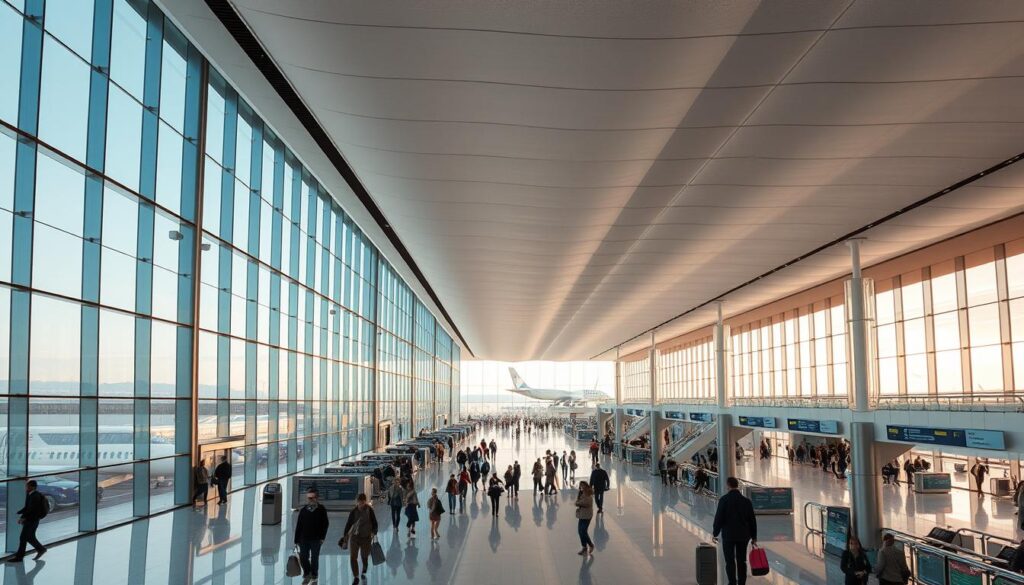As travelers, have you ever stopped to think about what makes your journey through the airport so seamless? Is it the efficient check-in process, the ease of navigating through terminals, or the availability of modern amenities? The answer lies in effective aviation facility design.
With the average airport terminal in the United States being around 40 years old, there’s a pressing need for modernization to accommodate growing passenger numbers and new security standards. Modern airport infrastructure design focuses on creating a smooth, safe, and enjoyable travel experience.
By incorporating innovative airport engineering services, airports can enhance passenger flow, improve security screening, and provide a more pleasant environment for travelers.
Key Takeaways
- Efficient aviation facility design is crucial for a seamless travel experience.
- Modernizing airport infrastructure is necessary to accommodate growing passenger numbers.
- Innovative airport engineering services can enhance passenger flow and security.
- A well-designed airport terminal can improve the overall travel experience.
- Effective airport infrastructure design focuses on safety, functionality, and passenger experience.
Importance of Airport Infrastructure Design
Well-designed airport infrastructure is essential for a seamless travel experience. As air travel continues to grow, the importance of effective airport design becomes increasingly evident. According to a survey, 62% of travelers consider the airport experience a significant factor in their overall travel satisfaction.
Boosting Passenger Satisfaction
A well-designed airport can significantly enhance passenger satisfaction by providing a comfortable and stress-free environment. This includes efficient check-in and security processes, clear signage, and ample amenities. By streamlining these processes, airports can reduce wait times and improve the overall travel experience. For instance, implementing advanced airport project management techniques can help in achieving these goals.
Facilitating Efficient Operations
Efficient airport operations are crucial for minimizing delays and ensuring smooth flight connections. Effective airport development planning involves designing layouts that facilitate the easy movement of passengers and aircraft. This includes strategically planning runways, taxiways, and terminals to reduce congestion. Moreover, incorporating airport modernization strategies can further enhance operational efficiency.
Supporting Economic Growth
Airports play a vital role in supporting local economies by facilitating trade and tourism. A well-designed airport can attract businesses and tourists, contributing to economic growth. For more insights on key considerations for airport planning and design, visit IATA’s Knowledge Hub. Effective airport infrastructure design is thus crucial for regional development.
Key Components of Airport Infrastructure
Understanding the key components of airport infrastructure is essential for appreciating its complexity. Airport infrastructure is a multifaceted system that includes several critical elements working together to ensure safe, efficient, and comfortable travel experiences.
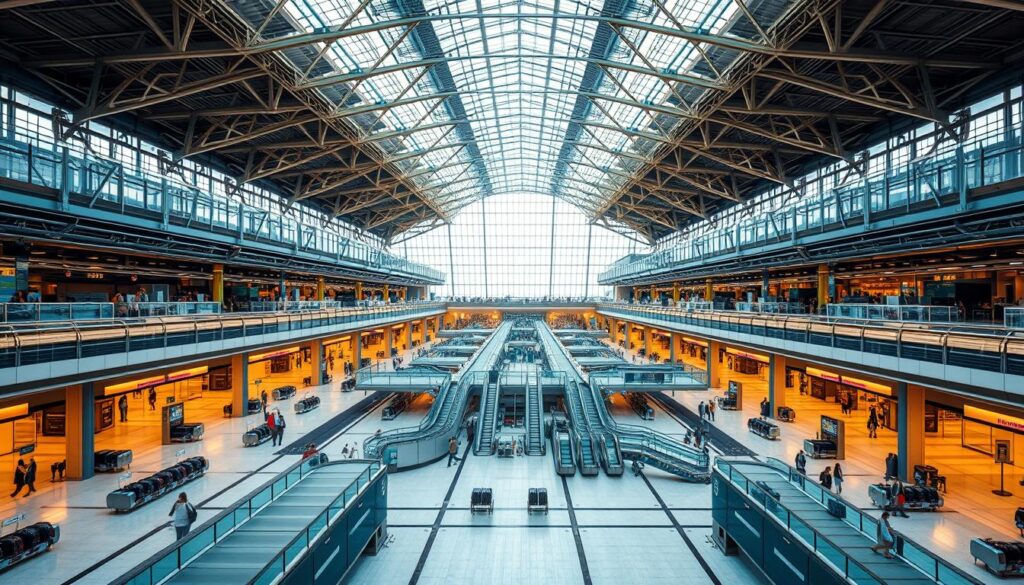
Runways and Taxiways
Runways and taxiways are fundamental to airport operations, serving as the pathways for aircraft takeoff, landing, and maneuvering on the ground. Efficient runway and taxiway design is crucial for minimizing delays and ensuring safety. This includes considerations for length, width, and surface material to accommodate various aircraft types and weather conditions.
In the context of airport construction management, the planning and maintenance of runways and taxiways are prioritized to prevent deterioration and ensure compliance with aviation standards.
Terminals and Gates
Terminals and gates are where passengers interact most directly with airport infrastructure. Terminals house check-in facilities, security checkpoints, and amenities, while gates are where aircraft are boarded. The design of these areas significantly impacts passenger experience, with considerations for comfort, wayfinding, and processing efficiency.
Airport facility upgrades often focus on enhancing terminal and gate facilities to improve passenger flow and satisfaction. This can include expansions, renovations, and the integration of new technologies to streamline processes.
Control Towers
Control towers are the nerve centers of airport operations, where air traffic controllers coordinate the movement of aircraft on the ground and in the air. The design and equipment of control towers are critical for effective air traffic management, requiring advanced communication and surveillance systems.
The role of control towers in airport construction management involves ensuring that these facilities are equipped with the latest technology and designed to support the controllers’ needs, enhancing overall airport efficiency and safety.
Modern Trends in Airport Design
The future of airport design is being shaped by three key trends: sustainability, smart technology, and passenger-centric approaches. These modern trends are transforming the way airports operate, making them more efficient, environmentally friendly, and comfortable for travelers.
Sustainability Practices
Airports are increasingly incorporating sustainability practices into their design, such as energy-efficient lighting and renewable energy sources, to reduce their environmental impact. For instance, some airports are using solar panels to generate electricity, while others are implementing rainwater harvesting systems to conserve water.
The use of sustainable materials in construction is also becoming more prevalent, with airports opting for materials that are recycled, recyclable, or sustainably sourced. This not only reduces the environmental footprint of the airport but also enhances its reputation as a responsible and eco-friendly facility.
Smart Technology Integration
The integration of smart technology is revolutionizing airport operations, enhancing security, and improving the passenger experience. Airports are leveraging technologies such as biometric identification, artificial intelligence, and the Internet of Things (IoT) to streamline processes and provide real-time information to travelers.
For example, some airports are using AI-powered chatbots to assist passengers with queries and provide personalized recommendations. Others are implementing IoT sensors to monitor and manage airport facilities, such as lighting and temperature control, more efficiently.
Passenger-Centric Designs
Passenger-centric designs are becoming a priority in modern airport design, focusing on creating a more comfortable, convenient, and enjoyable travel experience. This includes the provision of amenities such as free Wi-Fi, comfortable seating areas, and a wide range of dining and shopping options.
Airports are also designing their facilities with the needs of different passenger groups in mind, such as families with young children, business travelers, and passengers with disabilities. This involves creating accessible pathways, providing appropriate facilities, and ensuring that information is clearly communicated to all passengers.
By embracing these modern trends in airport design, airports can enhance the travel experience, improve operational efficiency, and reduce their environmental impact. Effective airport master planning and collaboration with airport design consultants are crucial in achieving these goals.
Designing for Safety and Security
Safety and security are the cornerstones of effective airport infrastructure design. As airports continue to evolve, the integration of advanced safety and security measures becomes increasingly important.
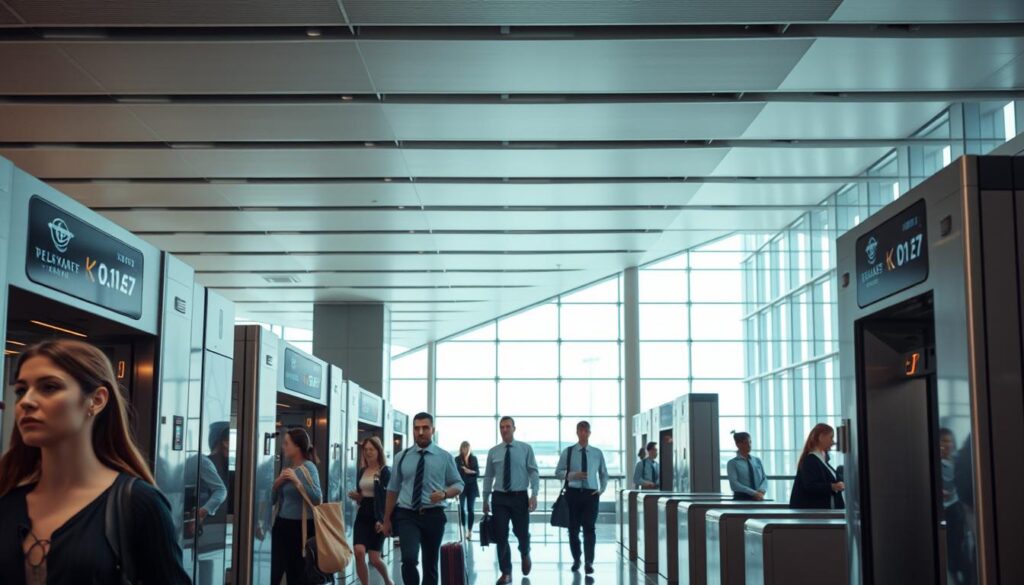
The modern airport must balance the need for robust security with the goal of providing a seamless and stress-free experience for passengers. This involves incorporating comprehensive screening measures, developing sophisticated emergency response systems, and implementing rigorous passenger safety protocols.
Comprehensive Screening Measures
Modern security requirements demand a larger footprint for security machines, such as CT scanners, which can take up over 1,000 square feet per security area. Effective airport infrastructure design must accommodate these needs while minimizing the impact on passenger flow.
For instance, airports are now adopting advanced imaging technologies that can detect a wide range of threats, from explosives to prohibited items. These technologies are being integrated into the airport’s design to ensure efficient screening processes.
“The future of airport security lies in the integration of technology and design, creating a safer and more efficient travel experience.”
Emergency Response Systems
Airports must be prepared to respond to emergencies effectively. This involves designing emergency response systems that can quickly and efficiently manage a range of scenarios, from medical emergencies to security breaches.
| Emergency Type | Response System | Design Consideration |
|---|---|---|
| Medical Emergency | First aid facilities and trained responders | Accessibility and visibility |
| Security Breach | Advanced surveillance and access control | Integration with security personnel |
Passenger Safety Protocols
Passenger safety protocols are a critical component of airport infrastructure design. These protocols include clear signage, effective crowd management strategies, and the design of safe and accessible facilities.
Airports are also leveraging airport development design training to enhance their safety and security measures, ensuring that staff are equipped to manage a range of scenarios effectively.
By prioritizing safety and security in airport infrastructure design, airports can create a safer and more secure environment for passengers and staff alike.
Accessibility in Airport Infrastructure
Accessible airport design is not just about compliance; it’s about creating an inclusive environment for travelers of all abilities. Airports are enhancing accessibility by providing ramps, elevators, and designated assistance services for passengers with disabilities.
Designing for All Abilities
Airports are now focusing on designing facilities that cater to a wide range of needs. This includes wheelchair-accessible restrooms, clear signage, and quiet areas for passengers who may be overwhelmed by the bustling environment.
The incorporation of assistive technology, such as audio announcements and Braille signage, further enhances the travel experience for passengers with visual or hearing impairments.
- Priority boarding for passengers with disabilities
- Accessible check-in counters
- Special assistance services
Transportation Links
Seamless transportation links are crucial for ensuring that all passengers can access the airport easily. This includes public transportation options like buses and trains, as well as designated pick-up and drop-off areas for private vehicles and ride-sharing services.
| Transportation Mode | Accessibility Features |
|---|---|
| Public Buses | Wheelchair ramps, designated stops near airport entrances |
| Rail Services | Elevated platforms, accessible ticketing machines |
| Ride-sharing Services | Designated pick-up and drop-off areas |
Wayfinding Solutions
Effective wayfinding is essential for navigating the complex airport environment. Airports are implementing clear and consistent signage, as well as digital wayfinding tools like mobile apps and interactive kiosks, to help passengers find their way.
By incorporating these accessibility features, airports can significantly enhance the travel experience for all passengers, making air travel more enjoyable and stress-free.
The Role of Green Spaces
As part of airport modernization strategies, the inclusion of green spaces is gaining significant attention. Airports are now recognizing the importance of integrating natural elements into their design to enhance the overall travel experience.

The incorporation of green spaces in aviation facility design is not just aesthetically pleasing; it also offers numerous benefits. These areas can help mitigate the environmental impact of airport operations.
Environmental Benefits
Green spaces in airports contribute to a reduction in carbon emissions and help to improve air quality. By incorporating plants and trees, airports can create natural buffers that absorb pollutants and reduce noise levels.
For instance, the green revolution in airports is a growing trend where airports are adopting sustainable practices, including the use of green roofs and walls to insulate buildings and reduce energy consumption.
Enhancing Aesthetics
Green spaces also play a crucial role in enhancing the aesthetic appeal of airports. Well-designed gardens and green areas can create a welcoming atmosphere, making the travel experience more enjoyable for passengers.
Airports like Singapore’s Changi Airport have set a high standard for incorporating green spaces into their design. Changi Airport features impressive indoor gardens and green walls, providing a serene environment for travelers.
Passenger Wellbeing
The presence of green spaces can significantly impact passenger wellbeing. Studies have shown that being in nature or even just viewing natural environments can reduce stress levels and improve mood.
By providing green spaces, airports can offer passengers a much-needed respite from the stresses of travel, enhancing their overall experience. This is particularly important in today’s fast-paced travel environment where airports are striving to provide a more pleasant and comfortable experience for travelers.
Collaborating with Stakeholders
Collaborating with stakeholders is essential for creating airport infrastructure that meets the needs of all users. Effective airport project management involves working closely with various stakeholders to ensure that projects are completed on time, within budget, and to the required quality standards.
Engaging Local Communities
Engaging with local communities is a critical aspect of airport infrastructure development. It involves understanding their concerns, addressing potential issues, and ensuring that the project benefits the local economy. As noted by industry experts, “community engagement is key to the successful implementation of airport projects.”
“Airports must work closely with local communities to mitigate the impact of noise and other environmental concerns.”
Working with Airlines and Regulators
Airlines and regulatory bodies play a significant role in shaping airport infrastructure. Collaboration with these stakeholders ensures that airports are designed to meet operational requirements and comply with regulatory standards. Airport design consultants work closely with airlines to understand their needs and preferences, ensuring that the airport infrastructure supports their operations.
Involving Engineers and Architects
The involvement of engineers and architects is crucial in the design and development of airport infrastructure. These professionals bring their expertise to the table, ensuring that airports are designed with safety, efficiency, and sustainability in mind. By working together, airport design consultants can create innovative solutions that enhance the passenger experience and improve operational efficiency.
In conclusion, collaborating with stakeholders is vital for the success of airport infrastructure projects. By engaging with local communities, working with airlines and regulators, and involving engineers and architects, airports can be designed to meet the needs of all users, ensuring a smooth and enjoyable travel experience.
The Impact of COVID-19 on Design Planning
The COVID-19 pandemic has significantly influenced airport infrastructure design, prompting a reevaluation of existing planning strategies. Airports worldwide have had to adapt quickly to the new reality, incorporating health and safety measures into their design and operations.
One of the immediate responses to the pandemic was the implementation of enhanced health and hygiene measures. Airports have introduced stringent cleaning protocols, increased the availability of sanitizing stations, and implemented touchless technology where possible.
Health and Hygiene Measures
Airports have focused on enhancing cleaning protocols, including more frequent disinfection of high-touch areas such as check-in counters, security checkpoints, and boarding gates. The use of UV light disinfection and electrostatic spraying has become more prevalent.
The integration of touchless technology has been another key strategy. This includes touchless check-in, biometric screening, and digital signage to minimize physical contact between passengers and airport staff.

Modifying Spaces for Social Distancing
To accommodate social distancing requirements, airports have had to reconfigure their spaces. This has involved rearranging seating areas, re-marking floors to indicate safe distances, and in some cases, reducing capacity to comply with social distancing guidelines.
Some airports have also introduced one-way systems in terminals to reduce congestion and minimize the risk of close contact between travelers.
Future-Proofing Airports
The pandemic has highlighted the need for airport engineering services that can adapt to future health crises. Airports are now considering flexible design elements that can be easily modified in response to new challenges.
This includes designing terminals with modular components that can be reconfigured as needed, and incorporating advanced air filtration systems to improve indoor air quality.
By embracing these changes, airports can ensure they are better prepared to handle future pandemics and other challenges, providing a safer and more resilient travel experience for passengers.
Case Studies of Successful Airport Designs
Several airports have set benchmarks in design, incorporating elements that enhance both functionality and passenger experience. These airports serve as exemplary models for others looking to upgrade their infrastructure.
Hartsfield-Jackson Atlanta International Airport
Hartsfield-Jackson Atlanta International Airport is one of the busiest airports in the world, known for its efficient airport master planning. The airport’s design facilitates the movement of millions of passengers annually, with a complex system of concourses and gates.
The airport has implemented various airport facility upgrades over the years, including the expansion of its terminals and the improvement of its baggage handling systems. These upgrades have contributed to its reputation for efficiency and passenger satisfaction.
Denver International Airport
Denver International Airport, another major hub, was designed with a vision for future growth and efficiency. Its design includes a unique neo-futurist architecture that not only stands out aesthetically but also incorporates functional elements that enhance the passenger experience.
The airport’s master plan includes provisions for sustainable practices and the integration of smart technology, making it a model for modern airport design.
Changi Airport, Singapore
Changi Airport in Singapore is renowned for its exceptional passenger experience and innovative design. The airport features a range of amenities and services, including entertainment options, luxury shopping, and extensive dining facilities.
- Innovative terminal designs that maximize space and efficiency
- Integration of green spaces within the airport environment
- Advanced security and immigration processes
Changi Airport’s success can be attributed to its commitment to airport facility upgrades and its focus on creating a welcoming environment for passengers. The airport continues to evolve, incorporating new technologies and design elements to stay ahead of the curve.
For more insights into successful airport designs and the companies behind them, you can explore resources such as top civil engineering firms that have contributed to these projects.
Improving Airport
Effective airport project management is key to streamlining operations and improving passenger experience. As airports continue to grow and evolve, enhancing logistics and operational efficiency becomes increasingly important.
According to industry experts, “The ability to manage logistics effectively is the backbone of any successful airport.” This involves several critical components, including baggage handling systems, cargo facilities, and supply chain management.
Baggage Handling Systems
Efficient baggage handling systems are crucial for reducing wait times and increasing throughput. Modern airports are adopting advanced technologies, such as automated baggage handling systems, to improve efficiency. For instance, a study on embracing visualization in airport infrastructure projects highlights the benefits of innovative technologies in enhancing operational efficiency.
As noted by industry leaders, “Implementing advanced baggage handling systems can significantly reduce congestion and enhance the overall passenger experience.” Embracing visualization in airport design can lead to more efficient and streamlined processes.
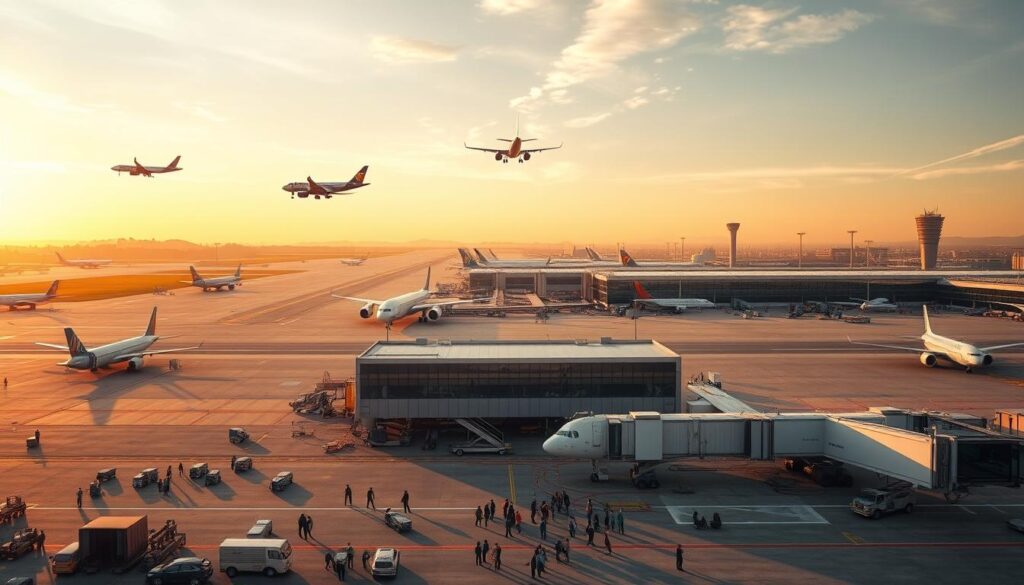
Cargo Facilities
Cargo facilities play a vital role in airport operations, handling a significant volume of goods and cargo. Enhancing cargo facilities involves investing in modern infrastructure and technology to streamline cargo handling processes.
- Improving cargo handling equipment and facilities
- Implementing efficient cargo processing systems
- Enhancing security measures for cargo handling
Supply Chain Management
Effective supply chain management is essential for ensuring the smooth operation of airport logistics. This involves coordinating with various stakeholders, including airlines, logistics providers, and regulatory bodies.
By optimizing supply chain management, airports can reduce costs, improve efficiency, and enhance overall operational performance. As the aviation industry continues to evolve, adopting innovative approaches to airport construction management and logistics will be crucial for meeting future demands.
Integrating Transportation Options
Integrating transportation options is a key aspect of airport modernization strategies, aimed at enhancing passenger satisfaction. Airports are now focusing on creating seamless travel experiences by incorporating various transportation modes.
One of the primary ways airports achieve this is through public transit connections. By linking airports to city centers and surrounding areas via buses, trains, or subways, airports make it easier for passengers to reach their final destinations. For instance, many major airports have dedicated rail links, reducing travel time and increasing convenience.
Public Transit Connections
Public transit connections are a crucial element in airport infrastructure. They not only provide passengers with affordable and efficient travel options but also help in reducing traffic congestion around airports. Airports like Frankfurt Airport and Hong Kong International Airport have exemplary public transit systems, offering passengers a hassle-free journey.
Ridesharing Services
Ridesharing services have become increasingly popular, and airports are adapting to this trend by integrating ridesharing options into their transportation networks. Designated pickup and drop-off areas for services like Uber and Lyft are now common at many airports, streamlining the process for passengers.
Parking Solutions
Efficient parking solutions are another critical aspect of airport transportation. Airports are implementing advanced parking management systems, including real-time parking availability and pre-booking options, to reduce congestion and enhance the passenger experience. Some airports are also exploring innovative solutions like automated parking systems to further improve efficiency.
By integrating these transportation options, airports are not only enhancing the travel experience but also contributing to airport facility upgrades. This holistic approach to transportation integration is a significant step forward in airport modernization strategies, making air travel more accessible and convenient for passengers.
Future Challenges in Airport Infrastructure
Airport infrastructure design must adapt to emerging challenges to ensure a sustainable and efficient travel experience. As the aviation industry continues to grow, it faces a complex array of issues that require innovative solutions.
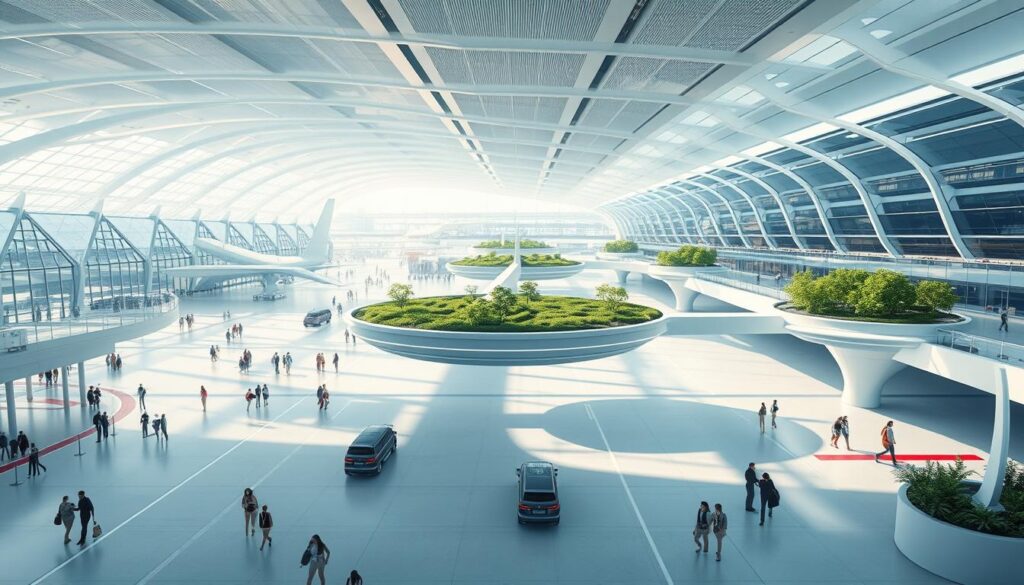
Climate Change Considerations
One of the significant challenges facing airport infrastructure is climate change. Rising sea levels and extreme weather events pose a threat to airport operations, necessitating resilient design practices. Airports must incorporate green infrastructure and sustainable practices to mitigate their environmental impact.
Adapting to Rising Passenger Numbers
The continuous growth in air travel demand presents another challenge for airport infrastructure. Airports must expand their capacity while maintaining efficient operations. This involves optimizing terminal design and implementing advanced passenger processing systems to reduce congestion and enhance the travel experience.
Addressing Technological Advances
Technological advancements are transforming the aviation industry, with airports needing to integrate new technologies to remain competitive. This includes adopting biometric screening for enhanced security, implementing smart airport technologies for improved efficiency, and leveraging data analytics to inform decision-making.
By addressing these challenges through innovative design and planning, airports can ensure a sustainable and efficient future for air travel. The key is to strike a balance between capacity expansion, technological integration, and environmental sustainability.
Conclusion: The Future of Airport Infrastructure Design
The future of airport infrastructure design is poised to revolutionize the travel experience, driven by innovations in airport master planning and the expertise of airport design consultants.
As the aviation industry continues to evolve, effective airport infrastructure design will play a critical role in enhancing the passenger experience, ensuring safety, and promoting sustainability. By integrating advanced technologies and sustainable practices, airports can improve operational efficiency and reduce their environmental footprint.
Transportation engineers play a vital role in shaping the future of airport infrastructure, as highlighted in the article on transportation engineering. Their work in designing and optimizing airport layouts, infrastructure, and systems is crucial for accommodating growing passenger demands and adapting to changing environmental conditions.
Innovative Airport Design
Continuing innovations in airport design will be crucial in addressing future challenges, from rising passenger numbers to climate change considerations. By leveraging the expertise of airport design consultants and adopting innovative airport master planning strategies, airports can stay ahead of the curve.
Resilient Airports
Building resilient airports that can adapt to changing demands will require a collaborative approach, involving stakeholders from across the aviation industry. By working together, airports can create a more sustainable, efficient, and passenger-centric travel experience.
